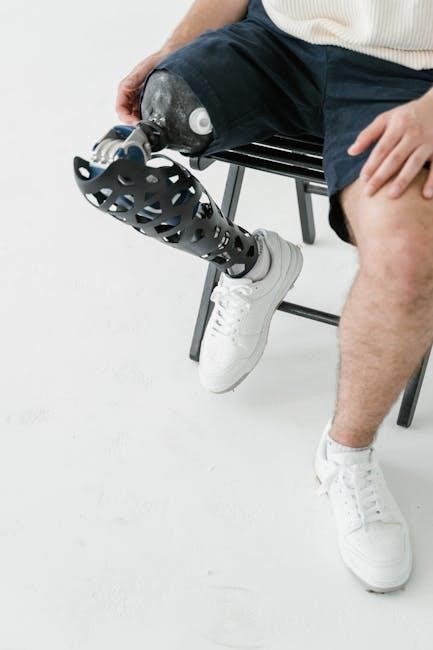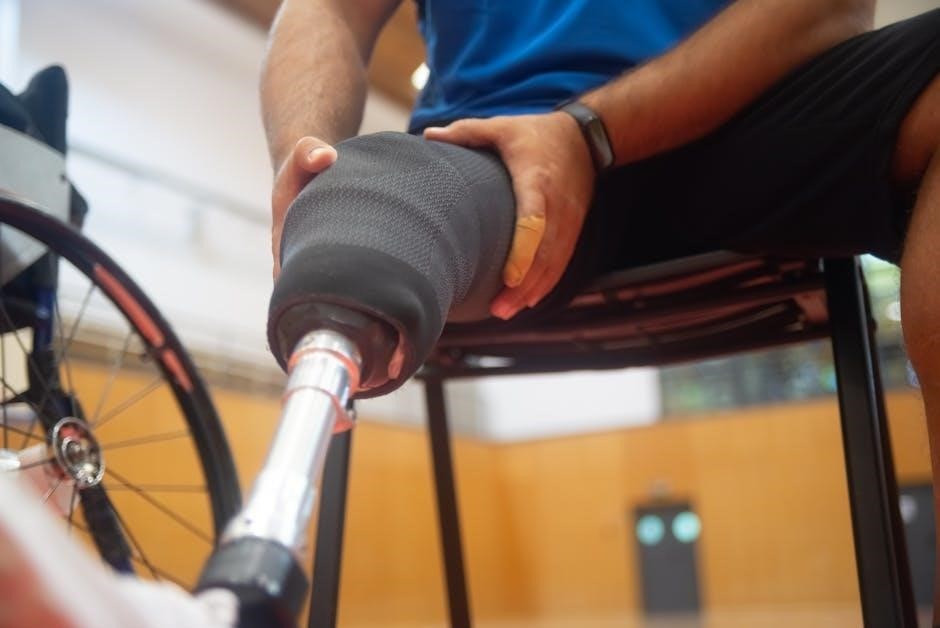Total hip replacement rehabilitation is a structured process aimed at restoring mobility, strength, and function post-surgery. It involves tailored protocols, exercise programs, and clinical guidance to ensure optimal recovery and return to daily activities.
1.1 Overview of Total Hip Replacement (THR)
Total hip replacement (THR) is a surgical procedure where the damaged hip joint is replaced with prosthetic components. It is commonly performed to alleviate pain, restore mobility, and improve quality of life, particularly in cases of severe arthritis, fractures, or degenerative conditions. The surgery involves replacing the femoral head and acetabulum with artificial parts, ensuring proper alignment and function. Post-operative rehabilitation plays a critical role in achieving optimal outcomes, focusing on regaining strength, range of motion, and functional independence. A well-structured rehabilitation protocol is essential to guide patients through recovery, addressing individual needs and minimizing complications.
1.2 Importance of Rehabilitation in THR
Rehabilitation is crucial for achieving optimal outcomes after total hip replacement (THR). It helps restore hip function, strength, and mobility, enabling patients to return to daily activities and improve their quality of life. A structured rehabilitation program addresses post-surgical challenges, such as pain, limited range of motion, and muscle weakness. It also ensures proper healing and alignment of the prosthetic components. By following a tailored protocol, patients can minimize complications, reduce recovery time, and regain independence. Rehabilitation is not just about physical recovery but also about educating patients on proper movement techniques and precautions to avoid future issues. This structured approach ensures long-term success and patient satisfaction.

1.3 Purpose of a Rehabilitation Protocol
A rehabilitation protocol for total hip replacement (THR) serves as a structured, evidence-based plan to guide patients through recovery. Its primary purpose is to ensure a safe and effective return to functional activities by addressing individual needs and promoting optimal healing. The protocol outlines timelines, exercises, and precautions to prevent complications and support long-term joint health. It also provides clear goals and milestones, helping patients and clinicians track progress. By standardizing care, the protocol minimizes variability and enhances consistency in treatment. Ultimately, it aims to restore mobility, strength, and independence while reducing the risk of setbacks. The protocol is adaptable, allowing adjustments based on patient response and clinical judgment.
Pre-Surgical Preparation and Education
Pre-surgical preparation and education are crucial for setting realistic expectations and ensuring patients understand their role in recovery. This phase includes assessments and personalized planning.
2.1 Patient Education on Rehabilitation Goals
Patient education is a cornerstone of successful rehabilitation, ensuring individuals understand their recovery objectives. Clear communication about realistic expectations, timelines, and the importance of adherence to protocols is essential. Educating patients on their active role in rehabilitation helps build motivation and compliance. This phase includes discussing specific exercises, such as glute sets and quad sets, to maintain hip precautions and promote early mobilization. Patients are also informed about the progression of exercises, from initial range of motion to strengthening and functional mobility. This tailored approach ensures patients are well-prepared and engaged in their recovery journey, fostering a collaborative relationship between the patient and healthcare team.
2.2 Setting Realistic Expectations for Recovery
Setting realistic expectations is crucial for patient satisfaction and motivation during rehabilitation. Recovery timelines vary, but most patients achieve significant progress within 3-6 months. Factors such as age, pre-surgery health, and adherence to protocols influence outcomes. Patients should understand that early gains may be slow, with gradual improvements in mobility and strength. It’s important to balance optimism with realism, acknowledging potential limitations post-surgery. Clear communication about recovery phases, from initial mobilization to advanced activities, helps manage expectations. Patients are encouraged to focus on consistent progress rather than comparing their journey to others. This approach fosters a positive mindset and supports long-term success in rehabilitation.
2.3 Pre-Rehabilitation Assessment and Planning
A comprehensive pre-rehabilitation assessment is essential to identify individual needs and develop a tailored plan. This includes evaluating the patient’s physical condition, medical history, and lifestyle. Assessments may involve strength testing, range of motion measurements, and functional ability evaluations. Setting specific, measurable, achievable, relevant, and time-bound (SMART) goals ensures a focused approach. A personalized rehabilitation plan is created, addressing any pre-existing conditions or limitations. This step also involves educating the patient on their role in the process and ensuring they are mentally prepared for the journey ahead. Proper planning lays the foundation for a smooth and effective recovery process.

Immediate Post-Operative Care
Immediate post-operative care focuses on pain management, wound care, and early mobilization to prevent complications. Monitoring for infection and ensuring patient comfort are critical during this phase.
3.1 Pain Management Strategies
Pain management is crucial in the immediate post-operative phase to enhance patient comfort and facilitate early mobilization. Multimodal analgesia, combining medications like opioids, NSAIDs, and local anesthetics, is commonly used. Non-pharmacological strategies, such as ice therapy and gentle positioning, also play a role. Patient-controlled analgesia (PCA) allows individuals to manage their pain effectively. It is important to balance pain relief with minimizing opioid-related side effects. Regular monitoring of pain levels ensures timely adjustments to the treatment plan. Effective pain management supports early mobilization and reduces the risk of complications, promoting a smoother recovery process.
3.2 Early Mobilization Techniques
Early mobilization is essential for preventing complications and promoting recovery after total hip replacement. Techniques include gentle range-of-motion exercises, such as ankle pumps and heel slides, to maintain joint flexibility. Weight-bearing status is carefully managed, with many patients allowed to bear weight as tolerated under supervision. Assistive devices like walkers or crutches are often used to reduce stress on the hip. Patients are encouraged to perform controlled movements, avoiding excessive flexion, abduction, or internal rotation. Early mobilization helps prevent muscle atrophy, improves circulation, and enhances functional recovery. A structured approach ensures safety and adherence to hip precautions, minimizing the risk of dislocation or other setbacks.
3.4 Wound Care and Infection Prevention
Proper wound care and infection prevention are critical in the early post-operative phase of total hip replacement rehabilitation. Patients are instructed to keep the surgical site clean and dry, avoiding submersion in water until the wound is fully healed. Dressings are typically changed using sterile technique to minimize infection risk. Patients are educated on signs of infection, such as redness, swelling, or increased pain, and urged to report these promptly. Antibiotics may be prescribed prophylactically or in response to confirmed infection. Regular follow-ups with healthcare providers ensure wound healing progresses as expected, safeguarding against complications and promoting a smooth recovery process.
Early Rehabilitation Phase (0-6 Weeks Post-Op)

This phase focuses on restoring mobility, strength, and function. Patients perform exercises like glute sets, quad sets, and transverse abdominis to maintain hip precautions and promote healing.
4.1 Weight-Bearing Status and Precautions
Weight-bearing status is critical in early rehabilitation, often prescribed as non-weight bearing, partial, or full, depending on surgical approach and patient condition. Patients must adhere to precautions to avoid complications like dislocation or implant failure. Assistive devices, such as walkers or crutches, are commonly used to support mobility while minimizing stress on the hip joint. Clear communication from the healthcare team ensures patients understand their specific weight-bearing limitations. Proper education on movement techniques, such as avoiding bending past 90 degrees or crossing the legs, is essential to maintain hip precautions and promote healing during this phase.
4.2 Range of Motion Exercises
Range of motion exercises are essential to restore hip mobility and flexibility post-surgery. Early exercises include glute sets, quad sets, and transverse abdominis activation, performed in supine or hook-lying positions to maintain hip precautions. These exercises help prevent stiffness and promote proper healing. Patients are guided to perform gentle movements within prescribed limits, avoiding flexion beyond 90 degrees or internal rotation. Progression to standing and seated exercises, such as hip abduction and extension, is introduced as tolerance allows. Consistency in performing these exercises ensures optimal joint mobility and prepares the hip for more advanced strengthening phases. Supervision by a physiotherapist is recommended to ensure adherence to guidelines and safety.
4.3 Strengthening Exercises for Hip Stabilizers
Strengthening exercises for hip stabilizers are crucial to restore muscle balance and support the new hip joint. Key exercises target the gluteus medius, gluteus minimus, and core muscles. Patients begin with isometric exercises like glute sets and progress to dynamic movements such as side-lying leg lifts and clamshells. Resistance bands or light weights are introduced to enhance strength. These exercises improve hip stability, reduce the risk of complications, and prepare the patient for functional activities. Supervision by a physiotherapist ensures proper technique and progression. Consistency in performing these exercises is vital to achieve long-term hip stability and prevent future mobility issues.
Intermediate Rehabilitation Phase (6-12 Weeks Post-Op)
This phase focuses on progressive resistance training, balance exercises, and functional mobility to enhance strength, stability, and coordination, preparing patients for daily activities and more complex movements.
5.1 Progressive Resistance Training
Progressive resistance training (PRT) is a key component of the intermediate phase, focusing on gradually increasing exercise intensity to build strength and endurance. This method involves using resistance bands, weights, or machines to target hip stabilizers, glutes, and core muscles. PRT helps restore functional strength, improving mobility and reducing the risk of future injuries. Despite its effectiveness, studies show that only 33% of rehabilitation programs consistently incorporate PRT, highlighting the need for greater emphasis. Tailored to individual progress, PRT ensures a safe and effective transition toward more demanding activities, enhancing overall recovery outcomes and preparing patients for advanced rehabilitation stages.
5.2 Balance and Proprioception Exercises
Balance and proprioception exercises are crucial during the intermediate phase of rehabilitation, focusing on restoring the patient’s sense of body position and movement. These exercises, such as single-leg stands, wobble board activities, and mini balance challenges, help improve stability and reduce the risk of falls. Proprioceptive drills, like heel-to-toe walking and ankle strategies, enhance neuromuscular control. Clinicians often incorporate these exercises into daily routines, ensuring they align with the patient’s progress and hip precautions. The goal is to rebuild the connection between the hip joint and the brain, fostering better coordination and confidence in daily activities. Regular practice of these exercises accelerates functional recovery and prepares patients for more dynamic movements.
5.3 Functional Mobility Training
Functional mobility training focuses on activities that mimic daily tasks, such as sit-to-stand transitions, stair navigation, and transfers from bed to chair. These exercises aim to enhance patients’ ability to perform real-life movements safely and efficiently. Clinicians incorporate techniques like gait training with assistive devices, such as canes or walkers, to improve walking patterns and confidence. Patients also practice balancing while performing dual tasks, like reaching for objects, to simulate everyday challenges. This phase emphasizes progressing from controlled environments to more dynamic settings, ensuring patients can adapt to various situations. The goal is to restore independence in mobility and prepare patients for advanced activities, aligning with their rehabilitation protocol.

Advanced Rehabilitation Phase (3-6 Months Post-Op)
This phase focuses on advancing strength, endurance, and functional abilities, preparing patients for high-impact activities and return to sports or recreational pursuits, aligning with their rehabilitation goals.
6.1 High-Impact Activities and Restrictions
At 3-6 months post-op, patients may gradually resume high-impact activities, such as running or jumping, under medical guidance. However, activities that involve repetitive twisting, heavy lifting, or excessive stress on the hip joint are typically restricted to prevent dislocation or implant wear. Patients are advised to avoid high-risk sports or movements that could compromise the hip replacement. The rehabilitation team assesses individual readiness for such activities, ensuring proper healing and strength before progression. Clear guidelines are provided to balance activity levels with hip protection, aiming to maximize mobility while safeguarding the surgical outcome and long-term joint health.
6.2 Advanced Strengthening and Conditioning
Advanced strengthening and conditioning in the 3-6 month post-op phase focuses on enhancing muscle power, endurance, and functional capabilities. Patients progress to dynamic exercises, such as step-ups, balance board training, and resistance band work, to improve hip stability and strength. High-intensity resistance training is introduced to restore pre-surgical muscle function and promote long-term joint health. Activities like cycling and swimming are encouraged to maintain cardiovascular fitness without overloading the hip. The goal is to prepare the patient for return to sports or strenuous activities, ensuring proper technique and safety. A tailored program, guided by a physical therapist, helps maximize recovery and prevent future complications.
6.3 Return to Sports or Recreational Activities
Returning to sports or recreational activities after total hip replacement requires careful assessment and gradual progression. Patients are typically cleared for low-impact activities like cycling or swimming within 3-6 months, while high-impact sports may take longer. A physical therapist evaluates strength, stability, and range of motion to determine readiness. Activities are reintroduced in a controlled manner, ensuring proper technique to avoid stress on the new hip. Patients are educated on activity modifications and precautions to minimize risk of complications. The goal is to safely transition back to desired activities, promoting long-term joint health and functional independence. Adherence to rehabilitation protocols is crucial for successful outcomes.

Exercise Programs and Modalities
Exercise programs include home-based and clinic-based sessions, focusing on strength, flexibility, and functional mobility. Modalities like assistive devices and therapeutic exercises support recovery, guided by clinical judgment.
7.1 Home-Based Exercise Programs
Home-based exercise programs are essential for patients recovering from total hip replacement, offering flexibility and convenience. These programs typically include gentle exercises like glute sets, quad sets, and transverse abdominis activations, performed in supine or hook-lying positions to maintain hip precautions. Patients are encouraged to perform these exercises regularly to improve strength, flexibility, and functional mobility. The programs are tailored to individual needs, ensuring adherence to post-operative guidelines. Clinical judgment guides the selection of appropriate exercises, and patients are advised to avoid activities that may compromise hip stability. Home-based exercises play a crucial role in early recovery, helping patients progress toward more advanced rehabilitation phases.
7.2 Clinic-Based Rehabilitation Sessions
Clinic-based rehabilitation sessions provide structured, supervised environments for patients recovering from total hip replacement. These sessions are led by physical therapists who design personalized programs to address specific needs. Exercises often include glute sets, quad sets, and transverse abdominis activations, performed in positions that maintain hip precautions. Therapists also incorporate range-of-motion exercises and progressive resistance training to enhance strength and mobility. Clinic-based sessions ensure proper technique and adherence to rehabilitation protocols, minimizing the risk of complications. Regular attendance complements home-based exercises, fostering a comprehensive recovery approach. These sessions are crucial for monitoring progress, addressing challenges, and adjusting treatment plans to optimize outcomes and restore functional independence.
7.3 Use of Assistive Devices and Equipment
Assistive devices and equipment play a vital role in supporting patients during total hip replacement rehabilitation. Common tools include crutches, walkers, and canes to aid mobility while adhering to weight-bearing precautions. Reachers and grabbers help patients avoid bending or twisting, reducing strain on the hip. Elevated toilet seats and chairs minimize the need for deep sitting, which can dislocate the hip. These devices are particularly crucial in the early stages of recovery, ensuring safety and compliance with rehabilitation protocols. Proper use of assistive equipment prevents complications and promotes independence, allowing patients to perform daily activities confidently while their strength and mobility improve.

Managing Complications and Setbacks
Complications in THR rehabilitation, such as infections or dislocations, require prompt intervention. Monitoring for signs of infection and addressing mobility issues is critical. Blood clots and nerve damage are risks, necessitating early detection and treatment. Setbacks may involve revising rehabilitation plans or adjusting physical therapy strategies to ensure continued progress and patient safety.
8.1 Identifying and Addressing Complications
Early identification of complications, such as infections, dislocations, or blood clots, is crucial for effective management. Monitoring for signs like redness, swelling, or unusual pain is essential. Imaging and lab tests help confirm diagnoses. Addressing complications may involve antibiotics, surgical interventions, or adjustments to rehabilitation protocols. Blood clots require immediate medical attention, while nerve damage may necessitate specialized therapy. Dislocations are managed with bracing or revision surgery. Timely intervention ensures patient safety and prevents long-term functional limitations. A tailored approach, combining clinical expertise and patient monitoring, is vital to overcome setbacks and achieve optimal recovery outcomes.
8.2 Strategies for Overcoming Rehabilitation Plateaus
Rehabilitation plateaus occur when progress stalls despite consistent effort. To overcome this, clinicians reassess goals and adjust protocols. Incorporating new exercises or modalities, such as progressive resistance training or balance exercises, can reignite progress. Patient education on proper technique and adherence to home programs is crucial. Addressing psychological factors, like motivation, through counseling or support groups, can also help. Regular monitoring and adjustments ensure personalized care. Collaboration between patients and therapists fosters a dynamic approach, preventing stagnation and promoting continued improvement. Tailored interventions and open communication are key to breaking through plateaus and achieving long-term recovery success.
8.3 Psychological Support During Recovery

Psychological support is vital during total hip replacement recovery, as mental well-being directly impacts physical progress. Patients often experience anxiety, depression, or frustration due to limited mobility and lifestyle changes. Counseling and support groups can help address these emotions, fostering resilience and motivation. Educational resources and clear communication from healthcare providers reduce fears and uncertainties. Setting realistic goals and celebrating small achievements boosts confidence. Caregivers play a crucial role in providing emotional support and encouragement. A positive mindset enhances adherence to rehabilitation protocols and overall recovery outcomes. Addressing psychological needs ensures a holistic approach to healing, promoting both mental and physical well-being throughout the journey.

Outcomes and Long-Term Follow-Up
Effective rehabilitation protocols yield improved mobility, reduced pain, and enhanced quality of life. Regular follow-ups ensure long-term joint health and address potential complications promptly for optimal outcomes.
9.1 Measuring Rehabilitation Success
Rehabilitation success is measured through clinical assessments, functional improvements, and patient-reported outcomes. Key metrics include pain reduction, restored range of motion, and strength. Functional assessments evaluate gait, balance, and ability to perform daily activities. Patient satisfaction surveys and quality-of-life questionnaires provide subjective feedback. Adherence to rehabilitation protocols and progression through exercise phases are also tracked. Standardized tools, such as goniometers for range of motion and strength testing equipment, ensure objective measurements. Success is further defined by the patient’s ability to return to pre-surgery activities and maintain long-term joint health. Regular follow-ups help verify sustained improvements and address any lingering limitations or concerns.
9.2 Long-Term Hip Health Maintenance
Long-term hip health maintenance is crucial for sustaining the outcomes of total hip replacement. Patients are encouraged to adopt a healthy lifestyle, including regular low-impact exercises like swimming or cycling. Weight management and proper posture reduce stress on the hip joint. Avoiding high-impact activities and adhering to activity restrictions is essential to prevent wear and tear. Regular follow-ups with orthopedic specialists ensure the hip remains stable and functional. Patients should also avoid smoking and manage chronic conditions to promote overall joint health. A balanced diet rich in calcium and vitamin D supports bone strength. Adhering to the rehabilitation protocol and maintaining muscle strength through ongoing exercise helps preserve long-term hip function and quality of life.
9.4 Patient Satisfaction and Quality of Life
Patient satisfaction and quality of life are key outcomes of total hip replacement rehabilitation. Successful rehabilitation often leads to significant improvements in mobility, pain reduction, and the ability to perform daily activities. Patients typically report heightened satisfaction when rehabilitation goals are met, such as returning to hobbies or maintaining independence. Quality of life is further enhanced through psychological well-being, as regained functionality reduces dependency on others. Regular follow-ups and adherence to long-term care guidelines ensure sustained satisfaction. Patients who actively participate in their rehabilitation and maintain a healthy lifestyle often experience greater fulfillment and happiness in their post-surgical life, making the rehabilitation process worthwhile and impactful.
Future Directions in THR Rehabilitation
Future directions in THR rehabilitation focus on emerging trends, technology integration, and personalized protocols to enhance recovery efficiency and patient outcomes, ensuring tailored care for optimal results.
10.1 Emerging Trends in Rehabilitation Techniques
Emerging trends in THR rehabilitation emphasize personalized and technology-driven approaches. Wearable devices and AI platforms now monitor patient progress, enabling real-time feedback and tailored interventions. There is a growing focus on early mobilization and functional exercises to restore mobility and strength. Progressive resistance training (PRT) is gaining traction, though adoption varies among clinicians. Home-based programs are being optimized with virtual guidance, improving accessibility. Additionally, protocols are increasingly incorporating mindfulness and psychological support to address recovery challenges. These innovations aim to enhance efficiency, patient engagement, and long-term outcomes, ensuring rehabilitation aligns with modern healthcare advancements and individual patient needs for optimal results.
10.2 Role of Technology in Modern Rehabilitation
Technology plays a pivotal role in modern THR rehabilitation by enhancing precision, accessibility, and patient engagement. Wearable devices and mobile apps now track progress, ensuring adherence to protocols. AI-driven platforms analyze data to tailor exercises and monitor recovery milestones. Telehealth services provide remote consultations, reducing the need for in-person visits. Virtual reality (VR) is being explored for immersive rehabilitation experiences, while electronic health records (EHRs) streamline communication between healthcare providers. These advancements not only improve efficiency but also empower patients to take an active role in their recovery. Technology is revolutionizing rehabilitation, making it more personalized, effective, and accessible for patients undergoing total hip replacement.

10.3 Personalized Rehabilitation Protocols
Personalized rehabilitation protocols are tailored to individual patient needs, ensuring optimal recovery post-THR. These protocols consider factors like age, pre-surgery activity level, and surgical approach. By customizing exercises, weight-bearing status, and progression timelines, patients achieve faster and safer recovery. Healthcare providers use clinical judgment to adjust protocols based on patient response and goals. Personalized plans also incorporate lifestyle factors, such as occupation or recreational interests, to enhance functionality. Regular assessments and adjustments ensure the protocol remains aligned with the patient’s progress. This individualized approach minimizes complications and maximizes long-term outcomes, making rehabilitation more effective and patient-centered. Technology, like wearable devices, further enhances customization and monitoring.
